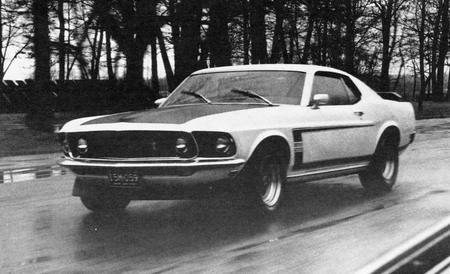The Mustang’s new-found handling ability demanded a greater revision of the engineering department’s philosophy than it did of suspension parts. Kicking the understeering habit is no easier than giving up the weed or peyote nuts and Ford is to be commended on its rehabilitation. One thing was in its favor from the very start and that is weight distribution—55.7% on the Boss 302’s front wheels compared to 59.3% for the 428 Mach 1. But there is more yet. Front springs and anti-sway bar are softer on the Boss while the rear leaf springs are stiffer—all of which tends to reduce understeer. Shock absorbers and the suspension geometry is carried over with no modifications.
Whether you order manual or power steering, the gear ratio is the same, at 16-to-one. The test car, with its manual steering, never could be accused of a lack of road feel when we were flailing. Unfortunately, in this crowded world, you can’t flail much and still keep a good grip on your driver’s license, and power steering is far better suited to routine traffic situations. We’ve driven far worse manual steering cars but parking the Boss 302 is still equal to about six push-ups.
The Boss 302 we drove is an engineering prototype and the only one in existence at press time. In fact, it had been in Ford’s wind tunnel to check the effect of the rear spoiler just before our session at the test track. Normally we avoid doing a full road test on a prototype because it might not be typical of a production car, but in this case the weatherman didn’t even give us a chance. The rain started between the handling course and Detroit Dragway, where the acceleration and braking parts of the test were to be conducted, and didn’t stop for the rest of the day. For that reason the performance data on the specification page has been calculated from information supplied by Ford’s engineering department—definitely not our normal procedure but better than nothing. We do have some very distinct driving impressions other than those on the handling course however, which should be passed along. Ride quality is toward the stiff side, particularly in the rear which crashes with vengeance over big irregularities in the road. Still, considering the handling, it’s a good trade out.
When you speak of engines in this class of car the Z/28, with its nervous and jerky deportment and ultra-quick response in the 12-cylinder, dohc, Italian fashion, is the standard of comparison. The Boss 302 has a temperament completely unlike its competitor. It idles smoothly and quietly with almost no mechanical noise and has average response, neither quick nor slow. It could easily find a home in a Falcon and no one would be the wiser, at least until the Holley’s secondaries snapped open. Ford claims that its new little motor actually makes more power than the Z/28 but, subjectively, the car doesn’t feel quite as fast. Certainly it doesn’t have the slightly tamed racing car personality which has won the Z/28 throngs of friends. Ford engineers even volunteered that the Boss can be readily launched in second gear and they’re right—for whatever that’s worth in your racer replica.
Roaring around Ford’s test track and splashing through Detroit from suburb to suburb has made believers out of us. If the production cars are anywhere near as good as the prototype, the Boss 302 is easily the best Mustang yet, and that includes all of the Shelbys and Mach 1s. After receiving no recognition other than gold stars for attendance in our road tests for the last several years Ford has learned its lessons well. The Boss 302 Mustang earned itself an A for this semester.


Leave a Reply